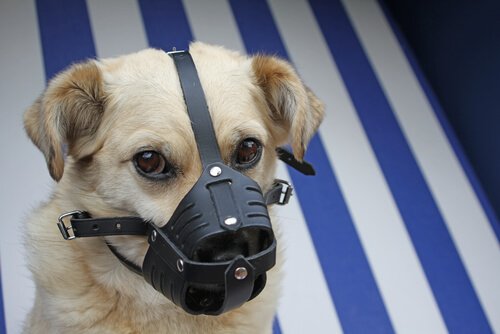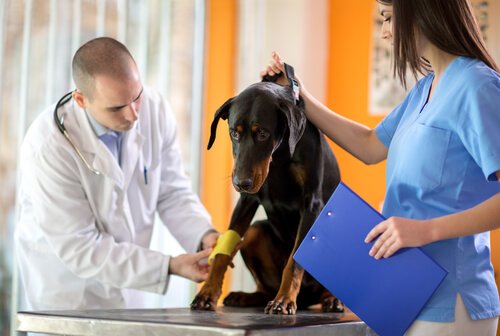How To Disinfect Your Dog's Wounds At Home

Cuts are common in all animals. They happen to humans, cats, and of course, dogs. Most of them are tiny and don’t require attention any attention at all, but when they are very large cuts, you have to disinfect and treat a dog’s wounds so they don’t turn into a bigger problem.
Disinfecting your dog’s wounds
Infections are one of the most common diseases in animals, which also makes them the main cause of complications. A poorly treated wound can complicate the life of your pet.
However, you shouldn’t be too alarmed, the main aspect of healing and disinfecting wounds is to remain calm, evaluate the situation and know whether you are capable of treating your dog’s wounds. Once you can verify the severity of the wound is, then you can proceed to treat it.
To do this, the products you need can be found at any pharmacy, and you don’t need any special medicine made just for pets.
How to evaluate the severity of the wound
When pets play or work, you may seem them complaining of certain symptoms throughout the day. If the cry or whimpering quite often, then you should check your pet to see what is bothering them.

When checking out a wound, you should never touch it with your bare hands or wash it with just water alone. This could cause an infection and make the situation even worse.
Most experts recommend putting a muzzle on the dog to prevent them from biting during the treatment. That way, treating your dog could be less complicated and you can focus better on your work. Also, they recommend cutting the hair around the wound with a small pair of scissors.
If you see any tendons, bones or a constant hemorrhage, then the wound is beyond your capability. So, it is best to take your pet to the veterinarian as soon as possible. It’s a good idea to apply pressure to the wound while taking them to the vet, that way you can prevent them from over bleeding.
However, if the wound stops bleeding and only shows flesh, you can treat it effectively. But first, you have to know how to disinfect the wound.
The process to disinfect your dog’s wounds
First, you should clean the affected area of the dirt and anything else that may be around it. To do so, use an antiseptic with iodine or soapy water. This process can be done by pouring the liquid directly on the wound or with an antiseptic gauze pad.
The warm water will also help the dog remain calm, which will be very helpful during the rest of the process. This washing should be continued for at least two minutes.

It’s a good idea to use a gauze pad because it won’t leave any remnants in the wound; in contrast to cotton, which does. Once you have done this, you should apply the solution that will help you to finish cleaning the wound. This will help it close and continue with the healing process.
The affected area may become inflamed, so applying a couple of bags of ice to the area may be helpful. Remember that if you want to apply other products to the wound, you have to first check that they are suitable for animals.
Conclusion
Once you have disinfected the wound, it’s time to leave it alone, and prevent your pet from re-opening it or scratching at it incessantly. Often, you can leave the wound out in the open air to heal faster.
However, if your pet is restless during this time, it’s best to bandage it to avoid any unwanted friction. Also, you may need to use an Elizabethan collar or special collar to prevent them from licking the wound or removing the bandage with their teeth.
You should check the bandaged wound every once in a while to make sure it’s healing properly. If you notice that the swelling doesn’t go down, there is pus around the wound or something else that doesn’t look normal, you should take your pet to the vet immediately.
However, if the wound is in better condition and doesn’t show any abnormalities, you can remove the collar, and your dog will sure appreciate it.
Cuts are common in all animals. They happen to humans, cats, and of course, dogs. Most of them are tiny and don’t require attention any attention at all, but when they are very large cuts, you have to disinfect and treat a dog’s wounds so they don’t turn into a bigger problem.
Disinfecting your dog’s wounds
Infections are one of the most common diseases in animals, which also makes them the main cause of complications. A poorly treated wound can complicate the life of your pet.
However, you shouldn’t be too alarmed, the main aspect of healing and disinfecting wounds is to remain calm, evaluate the situation and know whether you are capable of treating your dog’s wounds. Once you can verify the severity of the wound is, then you can proceed to treat it.
To do this, the products you need can be found at any pharmacy, and you don’t need any special medicine made just for pets.
How to evaluate the severity of the wound
When pets play or work, you may seem them complaining of certain symptoms throughout the day. If the cry or whimpering quite often, then you should check your pet to see what is bothering them.

When checking out a wound, you should never touch it with your bare hands or wash it with just water alone. This could cause an infection and make the situation even worse.
Most experts recommend putting a muzzle on the dog to prevent them from biting during the treatment. That way, treating your dog could be less complicated and you can focus better on your work. Also, they recommend cutting the hair around the wound with a small pair of scissors.
If you see any tendons, bones or a constant hemorrhage, then the wound is beyond your capability. So, it is best to take your pet to the veterinarian as soon as possible. It’s a good idea to apply pressure to the wound while taking them to the vet, that way you can prevent them from over bleeding.
However, if the wound stops bleeding and only shows flesh, you can treat it effectively. But first, you have to know how to disinfect the wound.
The process to disinfect your dog’s wounds
First, you should clean the affected area of the dirt and anything else that may be around it. To do so, use an antiseptic with iodine or soapy water. This process can be done by pouring the liquid directly on the wound or with an antiseptic gauze pad.
The warm water will also help the dog remain calm, which will be very helpful during the rest of the process. This washing should be continued for at least two minutes.

It’s a good idea to use a gauze pad because it won’t leave any remnants in the wound; in contrast to cotton, which does. Once you have done this, you should apply the solution that will help you to finish cleaning the wound. This will help it close and continue with the healing process.
The affected area may become inflamed, so applying a couple of bags of ice to the area may be helpful. Remember that if you want to apply other products to the wound, you have to first check that they are suitable for animals.
Conclusion
Once you have disinfected the wound, it’s time to leave it alone, and prevent your pet from re-opening it or scratching at it incessantly. Often, you can leave the wound out in the open air to heal faster.
However, if your pet is restless during this time, it’s best to bandage it to avoid any unwanted friction. Also, you may need to use an Elizabethan collar or special collar to prevent them from licking the wound or removing the bandage with their teeth.
You should check the bandaged wound every once in a while to make sure it’s healing properly. If you notice that the swelling doesn’t go down, there is pus around the wound or something else that doesn’t look normal, you should take your pet to the vet immediately.
However, if the wound is in better condition and doesn’t show any abnormalities, you can remove the collar, and your dog will sure appreciate it.
This text is provided for informational purposes only and does not replace consultation with a professional. If in doubt, consult your specialist.







